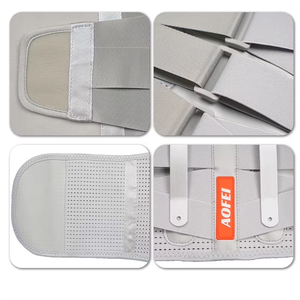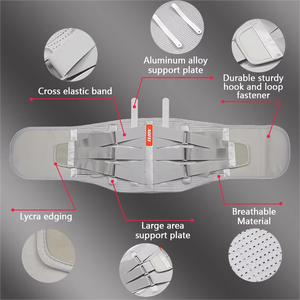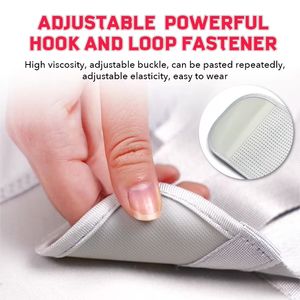(2665 products available)



































































































































































 Ready to Ship
Ready to Ship







































































An orthopedic waist belt is designed to support the lower back and abdominal muscles. It helps in healing, injury prevention, and offering support for conditions such as herniated discs and sciatica. There are several types of orthopedic waist belts, each tailored for different needs and preferences.
Adjustable Waist Belts
These orthopedic belts are customized for various sizes and levels of support. They come with adjustment straps and Velcro to modify the tension and fit. This adjustability permits precise compression and support, which is beneficial for dynamic users and individuals with fluctuating body sizes.
Posture Corrector Belts
This type of belt is designed explicitly for posture improvement. It provides support to the lumbar region and the spinal area, hence promoting the correct alignment of the body. Posture corrector belts are beneficial for individuals who sit for long periods or those with sedentary lifestyles. They can also be used by people experiencing posture-related discomfort.
Hernia Support Belts
These belts are specially made for individuals with hernias, including inguinal and umbilical hernias. They feature padding and panels that provide support to the hernia area and prevent further protrusion. Hernia support belts are often recommended as a temporary measure before surgical intervention or for post-surgery recovery.
Abdominal Binder Belts
These are wide belts that wrap around the abdomen and are used to offer general support to the lower back and abdominal muscles. They are especially useful after childbirth or abdominal surgeries as they assist in the healing process and reduce swelling. Abdominal binders are simple to use and are popular for their comfort and effectiveness in providing mild to moderate support.
Neoprene Waist Bels
These are made of neoprene material and are popular for their heat retention and compression capabilities. They are particularly useful for individuals with chronic back pain as they provide warmth and support to the affected area. Neoprene belts are also favored by athletes and fitness enthusiasts as they enhance performance and reduce the risk of injuries.
Orthopedic waist belts are versatile medical devices that provide support, stability, and compression to the lumbar spine and pelvic region. Their primary application is for individuals recovering from orthopedic injuries, surgeries, or those experiencing chronic pain in the lower back and hip area. These belts are essential tools in the field of orthopedics and rehabilitation.
Orthopedic waist belts are commonly used in scenarios such as:
Consultation with Healthcare Professionals
Before selecting an orthopedic waist belt, it is important to consult with a healthcare provider, such as a doctor, physical therapist, or chiropractor. These professionals can assess the individual's condition, injury, or posture problem and recommend the most suitable type of waist belt for their specific needs. They can also provide guidance on the correct size, level of support required, and any special features to consider.
Understanding the Types of Orthopedic Waist Belts
Orthopedic waist belts come in different types and designs, each serving a specific purpose. Lumbar support belts are designed to provide support and stability to the lower back. Abdominal support belts are used post-surgery or after injury to support the abdominal area. Posture corrective belts help in aligning the spine and improving posture. It is crucial to understand these types and their functions to choose the right one that addresses the specific issue.
Considering Comfort and Material
Comfort is a key factor when choosing an orthopedic waist belt. Look for belts made from breathable, soft, and hypoallergenic materials that are comfortable to wear for long periods. Adjustable straps and closures can also enhance comfort by allowing the user to customize the fit. Avoid belts with rigid or harsh materials that can cause skin irritation or discomfort.
Assessing Support and Compression Level
Different orthopedic waist belts offer varying levels of support and compression. For instance, those with severe back pain or post-surgery recovery may require a belt that provides high compression and support. On the other hand, those looking for mild support or preventive measures may opt for a belt with lower compression. It is important to assess the level of support needed and choose a belt that meets those requirements.
Posture Correction
Orthopedic waist belts help in correcting bad postures. They provide support and force the spine to be in its right position. These belts are useful to people who usually have slouched or humped shoulders as a result of spending a long period in front of a computer.
Pain Relief
These orthopedic belts are very essential when it comes to relieving lower back pains. When the belt is worn, it supports the lower back and reduces pressure on the spine. This relieves pain and discomfort in the lower back area.
Support for Injury
Orthopedic waist belts offer the required support for individuals who are recovering from injuries. They stabilize the lower back and the muscles around it, preventing further injuries during the recovery period.
Spinal Alignment
Orthopedic waist belts are very useful when it comes to assisting in spinal alignment. The belts offer support to the lumbar region of the spine, making it easy to achieve and maintain the right alignment. This is very important, especially for individuals experiencing spinal issues.
Material
Most orthopedic waist belts are made of breathable and elastic materials such as neoprene, polyester, and nylon. These materials are comfortable to wear and provide the right amount of support and compression.
Adjustable Straps
These belts usually come with adjustable straps. This allows users to adjust the tightness and pressure of the belt according to their comfort and support needs.
Support Panels
Many orthopedic waist belts have additional support panels. These panels provide extra support to the lower back and help in maintaining the right posture.
Compression
Orthopedic waist belts offer enough compression to the lower back area. This helps in reducing swelling and inflammation.
Ergonomic Design
These belts are designed in such a way that they are very comfortable to wear. They are usually lightweight and their designs enable easy movement.
Lumbar Support
Orthopedic waist belts come with additional lumbar support. This is achieved by including padding or support panels in the right places to provide optimum support to the lower back region.
Discreet Design
Some orthopedic waist belts are designed to be discreet. They can be worn under clothes without being noticed. This allows users to enjoy the benefits of the belt without drawing attention to themselves.
Q1: Is an orthopedic waist belt the same as a lumbar support belt?
A1: No, they are not the same. Although they may appear similar, orthopedic waist belts are designed specifically for medical purposes, such as post-surgery recovery or injury rehabilitation. They provide support, stability, and compression to the lower back and abdominal area, which aids in healing processes and improves posture. Conversely, lumbar support belts are typically used to prevent back pain and discomfort. They may offer general support to the lumbar region but do not have the targeted medical applications that orthopedic waist belts do.
Q2: Can someone wear an orthopedic waist belt all day?
A2: While orthopedic waist belts are designed to provide support and stability to the lower back and abdominal area, wearing them all day may not be necessary or comfortable for everyone. The amount of time one wears an orthopedic waist belt depends on various factors, such as the severity of the condition, the type of belt, and individual comfort levels. It's essential to consult with a healthcare professional or orthopedic specialist to determine the appropriate use and duration of an orthopedic waist belt for specific needs.
Q3: What are the signs that an orthopedic waist belt is working?
A3: There are several indicators that an orthopedic waist belt is doing its job. First, if the belt helps alleviate pain or discomfort in the lower back or abdominal area, this is a sign that it is providing the support and compression needed to relieve pressure on the affected muscles or spine. Second, if the belt helps improve posture and reduce slouching, it is likely providing the stability needed to maintain proper alignment in the lower back and pelvis.